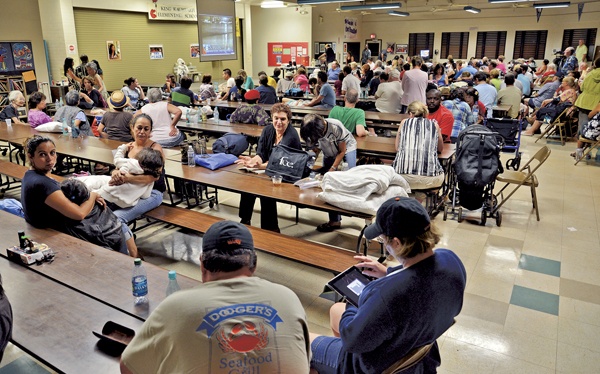LIHU‘E — Mayor Bernard Carvalho Jr. on Sunday praised all parties involved in the “excellent response” to a tsunami threat Saturday night. But to some Kaua‘i residents, there was a lot to be improved in future disaster threats, especially when
LIHU‘E — Mayor Bernard Carvalho Jr. on Sunday praised all parties involved in the “excellent response” to a tsunami threat Saturday night. But to some Kaua‘i residents, there was a lot to be improved in future disaster threats, especially when it comes down to giving proper public notice.
Each time that there has been a threat of a natural disaster, the county has been diligent in alerting Kapa‘a resident Valerie Weiss. But she said something went wrong Saturday, because the county’s Blackboard Connect CTY failed to let her know of the imminent danger.
“I’ve always been on the list, and I always get the call and this time I didn’t,” said Weiss, adding that at least two of her friends were also not notified by the county’s automatic telephone alert.
Weiss said when she called the county seeking an explanation, she was told by the operator that her name was not on the list. But Weiss said she never asked to have her name taken off the list, and that no one else has access to her landline operated by Hawaiian Telcom.
“Something’s gone wrong with the system, because I talked to other people who also didn’t receive that call,” she said.
County spokeswoman Beth Tokioka said the Blackboard Connect CTY system automatically loads all listed phone numbers into the system. Individuals can manually load unlisted numbers, cell numbers and email addresses. The county has been using this system for emergency notifications since May of 2009.
“We did experience many unsuccessful calls on Saturday evening, mostly due to ‘network overload’ — just too many people making calls and some of our Connect CTY calls could not get through,” Tokioka said. “Most of the people who did not get their call and reported it to us use AT&T as their service provider, so we’re not sure if AT&T was having unusual problems at that time.”
On the North Shore, Kilauea resident Evelyn Harris said she found out about the threat at 7:30 p.m., while watching TV. But it wasn’t until 9 p.m. that she heard the sirens from the state Civil Defense go off.
“People depend on those sirens,” said Harris, adding that her son and his wife live in Ha‘ena, on the North Shore’s far end, and also didn’t hear the sirens until late.
Kaua‘i Civil Defense officials said the Kaua‘i Police Department dispatch was notified of the tsunami threat at 7:09 p.m., and sounded the sirens at 8:07 p.m. But the county received reports that the sirens in Kilauea, Pua Loke, Aliomanu and Kaumakani did not sound during the threat.
There are 54 sirens around the island, and they are all property of the state Civil Defense, according to Ted Daligdig, manager of the Kaua‘i Civil Defense.
Additionally, the Civil Air Patrol provided notification to the Na Pali Coast, Ni‘ihau and Polihale areas via aerial broadcasts (siren and loud speakers) from their aircraft, according to Daligdig.
At about 1 a.m. Sunday, Daligdig said, the county sent a press release regarding the cancellation of the tsunami warning and issuance of the advisory, and Carvalho also provided similar messages to radio stations.
When asked what the county did right during the tsunami warning, Daligdig said it was the augmented sirens with Civil Air Patrol air messaging, messaging via Blackboard Connect CTY, continuous media updates and opening of holding areas in all regions of the island.
In areas that need improvement, Daligdig said it includes statewide coordination on siren sounding, timely deployment of roadblocks in coordination with state Highways Division and county Public Works Department. Also, there needs to be more education campaigns on tsunami awareness with hoteliers to improve evacuation of visitors, he said.
In contrast to tsunami threats generated elsewhere in the Pacific, a locally generated tsunami from the Big Island would have a very narrow window of reaction time before the first wave would arrive on Kaua‘i, according to Daligdig.
The approximate time is 35 to 40 minutes from generation to impact, he said.
“In order to get the message out, the Kaua‘i County receives the tsunami message, the official message from the Pacific Tsunami Warning center, and must generate and transmit a public notification,” Daligdig said.
“My estimate is that this process will take about seven minutes from earthquake tsunami generated warning. This is barring any unexpected communications grid lock.”
• Léo Azambuja, staff writer, can be reached at 245-3681 (ext. 252) or lazambuja@ thegardenisland.com.


